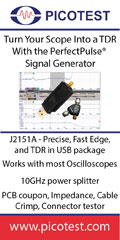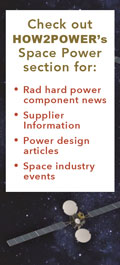 |
|
IN THIS ISSUE:
» Matching Driver IC And FETs Bring GaN Benefits To Low-Voltage POL Converters
» Integrated Current Limiter Eases Power Protection In High-Voltage Space Applications
» Design Platform Combines Ready-To-Use Motor Control Algorithm With Application-Oriented Enhancements
» Focus On Magnetics:
Power Magnetics Component Roundup
» Spotlight On Safety & Compliance:
X-Capacitor Discharge Must Satisfy Both Safety And Energy Efficiency Rules
» New Power Products
» Industry Events:
- Long Island Power Electronics Symposium Continues To Grow
- SiC and GaN Industry and Researchers Gather At WiPDA
» Other Top Power News
From the Editor's Desk David G. Morrison
Editor, HOW2POWER TODAY

Since the first GaN power devices were introduced about 10 years ago, the number of companies supplying these devices has expanded well beyond the startups. Now many of the major power semiconductor companies either have GaN components in their portfolios, or have announced plans to offer them. Some have even announced their successes in shipping GaN devices in volume. So far, most of the companies offering GaN devices list parts with 600-V or 650-V ratings, while one of the GaN specialists, EPC, has an extensive portfolio at 200 V and below. As the industry continues to ponder the future of GaN adoption in forums like WiPDA, the emergence of new devices in different voltage ratings gives us clues as to where the technology is headed. In this issue of the newsletter, we see the signs that GaN power devices are moving toward both lower and higher voltages, and some of the design implications. An article by Ron Vinsant discusses how the recent availability of low-voltage GaN FETs (30 V devices in this case) and matching driver ICs is paving the way for design of low-voltage point-of-load converters, such as those stepping down 12 V to 1 V. Meanwhile, an article in the Power Products section highlights two recently introduced single-die, e-mode GaN devices rated at 1200 V. Such devices open the door to using GaN in PV inverters, motor drives and other automotive applications. As more GaN suppliers look beyond the 650-V category (both above and below), we’ll learn more about GaN’s ability to improve power conversion in a wider range of applications. This issue of the newsletter also explores various other topics in power design, plus power component news and more. Happy Holidays to How2Power readers and all the best in the new year!
|
|

 |
 |

|
HOW2POWER EXCLUSIVE DESIGN ARTICLES 
|
Matching Driver IC And FETs Bring GaN Benefits To Low-Voltage POL Converters
by Ron Vinsant, uPI Semi Mountain View, Calif.
There are two well known advantages of using higher switching frequencies (>1 MHz) in lower voltage (12 V to 1 V) point-of-load (POL) dc-dc converters. First, the inductors are smaller. Secondly, less capacitance is needed in the output filter. A less discussed advantage is the potential for increased control loop bandwidth, which results in lower output capacitance to meet voltage excursion requirements during fast load transients. These benefits can’t be obtained using silicon MOSFETs without sacrificing efficiency. However, due to the recent advent of low-voltage GaN FETs and matching drivers, giving up efficiency is no longer necessary. This article will demonstrate the performance improvements that can be obtained when using GaN FETs in combination with suitable GaN FET drivers in 12-V input to 1-V output point-of-load converters.
Read the article…
|

When compared with a silicon-based DrMOS
solution for a 12-V to 1-V POL converter,
a GaN solution has better efficiency
at twice the operating frequency. |

|

This article provides an overview of
the main features in the RHRPMICL1A
rad-hard integrated current limiter,
describes circuit-level details of how
to use the device, and presents
experimental results. |
Integrated Current Limiter Eases Power Protection In High-Voltage Space Applications
by Salvo Pappalardo, STMicroelectronics, Milan, Italy and Ignazio Mirabella, STMicroelectronics, Catania, Italy
Latched current limiters (LCLs) have been extensively used in the aerospace environment, especially in the European institutional missions and for many years have been the fundamental power protection devices in earth observation satellites. However, nowadays, even if the functionality and the main performance requirements of these LCLs do not change from one project to another, they are routinely redesigned and implemented using discrete components. Obviously, an integration of certain key LCL functions could reduce or eliminate such redesigns. This opportunity was recognized by the ESA, which proposed development of an integrated current limiter of universal use, which in turn gave rise to the RHRPMICL1A IC, a rad-hard integrated current limiter (ICL). A high-voltage application solution described in this article allows its use in a power bus of 100 V or higher.
Read the article…
|

Design Platform Combines Ready-To-Use Motor Control Algorithm With Application-Oriented Enhancements
by Ingo Skuras, Infineon Technologies, Munich, Germany
The widening of the application scope for variable speed drives (VSDs) has driven Infineon to adopt a new approach in iMOTION, the company’s family of integrated solutions for the control of variable speed drives. These products integrate a production-grade control algorithm for the motor, and an optional power-factor correction (PFC) control algorithm along with all required hardware functions. This article describes why and how the hardware and software were changed to address the new application requirements, and how the new features and architectural changes in iMOTION 2.0 enable higher performance, reduce bills of materials and enhance design flexibility in the applications. A hair dryer design example illustrates how these new features are put to use in one of the newer applications for VSDs.
Read the article…
|

iMOTION motor controllers allow the motor
control building block to be defined
in such a way that it can be certified
as a functionally safe component. |

FOCUS ON MAGNETICS 
Sponsored by Payton Planar Magnetics
A monthly column presenting information on power magnetics design, products, or related technology |

Power Magnetics Component Roundup
by David G. Morrison, Editor, How2Power.com
With magnetic components continuing to dwarf the ICs and power semiconductors in many power converter designs, magnetics manufacturers continue their efforts to shrink their products by lowering their DCR and increasing their current ratings in a given package size. This trend is ongoing for off-the-shelf power inductors as reflected in recently introduced products. In addition to this broad trend in size reduction, magnetics manufacturers also continue to optimize their inductors for use in dc-dc converters, other SMPS designs and EMI filtering, by tailoring these products to specific applications. While automotive has perhaps been the most often targeted application area in recent years, the latest batch of power inductors also addresses requirements in industrial, telecom, computing and audio applications. Read this article to learn about recent developments in power inductors introduced over the past six months. In addition to power inductor news, this feature includes information on new inductor cores and magnetics-related literature.
Read the full article…
|

 |
 |

SPOTLIGHT ON SAFETY & COMPLIANCE 
Sponsored by Power Integrations
A monthly column discussing standards and regulatory requirements affecting power electronics |

X-Capacitor Discharge Must Satisfy Both Safety And Energy Efficiency Rules
by Kevin Parmenter, Chair, and James Spangler, Co-chair, PSMA Safety and Compliance Committee
Many products including power supplies and household products are connected to the ac line. Within these products we find the X capacitors used to provide line filtering. If no measures are taken to discharge these capacitors, they can retain a high-voltage charge even after ac power is removed from the product. There are regulations to prevent the consumer from being shocked if their fingers should touch the metal prongs of the ac power plug while they are removing it from the outlet. Satisfying these safety requirements for the discharge of X capacitors would be straightforward were it not for the energy efficiency standards, which are pervasive and over time are becoming more demanding. This article discusses both the safety and energy efficiency requirements, looks at the different circuit approaches to discharging X capacitors and how well they do in terms of satisfying the energy efficiency regulations.
Read the full article…
|

 |
 |

 — POWER PRODUCTS IN 3 IMAGES OR LESS — POWER PRODUCTS IN 3 IMAGES OR LESS 
|

|

GaN Power International’s
GPIHV15DK and GPIHV30DDP5L
GaN power FETs. |
1200-V Enhancement-Mode GaN Power Devices Challenge SiC
 Photo: The GPIHV15DK is 100-mΩ GaN power FET in a TO-252 package, while the GPIHV30DDP5L is a 60-mΩ GaN power FET in a TO-263-5. Introduced as the first enhancement-mode GaN power transistors at 1200 V, these devices bring the performance benefits of GaN to PV inverter, motor drive and automotive applications. Photo: The GPIHV15DK is 100-mΩ GaN power FET in a TO-252 package, while the GPIHV30DDP5L is a 60-mΩ GaN power FET in a TO-263-5. Introduced as the first enhancement-mode GaN power transistors at 1200 V, these devices bring the performance benefits of GaN to PV inverter, motor drive and automotive applications.
 Table: GaN vs. SiC switching figure-of-merit (QG*RDS(ON)) at 1200 V. Based on data sheet comparisons, E-mode lateral GaN offers 5 to 20 times better power switching performance than SiC devices on the market. Table: GaN vs. SiC switching figure-of-merit (QG*RDS(ON)) at 1200 V. Based on data sheet comparisons, E-mode lateral GaN offers 5 to 20 times better power switching performance than SiC devices on the market.
See the full story… |


 |

|


Infineon Technologies’
IGT40R070D1 E8220 and
IGLD60R190D1 CoolGaN power. |
GaN Power Transistors Target High-End Audio And SMPSs
 Photo: Targeting high end audio equipment, the 400-V GaN power transistor enables smoother switching and a more linear class D output stage. Meanwhile the 600-V 190-mΩ, industrial-grade GaN transistor has been cost reduced to provide the benefits of GaN in consumer and industrial applications. Photo: Targeting high end audio equipment, the 400-V GaN power transistor enables smoother switching and a more linear class D output stage. Meanwhile the 600-V 190-mΩ, industrial-grade GaN transistor has been cost reduced to provide the benefits of GaN in consumer and industrial applications.
See the full story…
|

UnitedSiC’s UF3SC SiC FETs.
|
SiC FETs Lower On-Resistance To Less Than 10 mΩ
 Graphs: When compared with similarly rated SiC MOSFETs, the UF3SC SiC FET cascode devices achieve significantly lower on-resistance. Graphs: When compared with similarly rated SiC MOSFETs, the UF3SC SiC FET cascode devices achieve significantly lower on-resistance.
 Table: Comparing the power losses of a 200-kW 8-kHz switching IGBT-based inverter versus designs using the UF3SC SiC FETs. Table: Comparing the power losses of a 200-kW 8-kHz switching IGBT-based inverter versus designs using the UF3SC SiC FETs.
 Graphs: Loss evaluation for a 60-kVA solar inverter with an 800-V dc link at three operating frequencies for a 2-level, an NPC and a TNPC inverter topology obtained using the packaged UF3SC SiC FETs. According to the company, until now achieving this level of performance required use of IGBT or SiC modules. Graphs: Loss evaluation for a 60-kVA solar inverter with an 800-V dc link at three operating frequencies for a 2-level, an NPC and a TNPC inverter topology obtained using the packaged UF3SC SiC FETs. According to the company, until now achieving this level of performance required use of IGBT or SiC modules.
See the full story…
|

AVX’s TransGuard automotive
VGAH series multilayer varistors.
|
Glass-Encapsulated Multilayer Varistors Rated For 150°C Operation
 Photo: Designed for use in high-temperature, high-energy, harsh-environment automotive, industrial, and oil & gas applications, these MLVs provide bidirectional overvoltage protection and broadband EMI/RFI filtering in a single surface-mount device. Photo: Designed for use in high-temperature, high-energy, harsh-environment automotive, industrial, and oil & gas applications, these MLVs provide bidirectional overvoltage protection and broadband EMI/RFI filtering in a single surface-mount device.
See the full story…
|

|










|
INDUSTRY EVENTS  |
|
Long Island Power Electronics Symposium Continues To Grow
by Ronald DeLuca, Chair IEEE PELS, Long Island Section
On November 7, the Long Island Chapter of the IEEE Power Electronics Society (PELS) hosted its third annual Power Electronics Symposium (PES) at the Radisson Hotel in Hauppauge, NY. This year the symposium hosted over 52 exhibitors and noted many more on the waiting list. Exhibitors showcased a number of power products including ac-dc power supplies, dc-dc converters, power semiconductors, passive components, magnetics, electro-mechanical devices, thermal management products, test equipment and compliance services. The symposium continues to grow and attract people from the tri-state area and beyond. In attendance were power professionals, engineers, designers and component manufacturers from local, regional and worldwide corporations. Over 475 participants’ attended, and it was commented a number of times how engaged each exhibitor was discussing their products and services.
Read the full story… |
|
SiC and GaN Industry and Researchers Gather At WiPDA
For anyone involved with the development of SiC and GaN power semiconductors as well as those working to apply them, the Workshop on Wide Bandgap Power Devices and Applications (WiPDA) continues to be the forum for learning about the latest technical developments and trends. It’s also where members of industry and academia discuss the challenges and issues that still need to be addressed for the continued adoption and growth of these wide-bandgap devices. Among the many practical topics that receive attention here are device reliability and industry progress in validating it for SiC & GaN. This year’s WiPDA also provided a forum for the JEDEC JC-70 committee to discuss the WBG standards they are developing as well as a meeting of the International Technology Roadmap on Wide Bandgap Semiconductors (ITRW). Mark Scott, WiPDA 2019 Publicity Chair, reported on these and other highlights from this year’s workshop in the latest issue of the PSMA newsletter.
See the article… |

|

OTHER TOP POWER NEWS
|
|
 Secure the opportunity to present your technical knowledge on the largest platform for the electrical and electromechanical energy conversion field—submit a digest for ECCE 2020. Paper proposals must be submitted on the ECCE 2020 submission portal by January 15, 2020. For topics, see the call for papers. Secure the opportunity to present your technical knowledge on the largest platform for the electrical and electromechanical energy conversion field—submit a digest for ECCE 2020. Paper proposals must be submitted on the ECCE 2020 submission portal by January 15, 2020. For topics, see the call for papers.
 A joint website has been launched for the CPES and PEC conferences, which will run April 5-8, 2020 at Virginia Tech. A joint website has been launched for the CPES and PEC conferences, which will run April 5-8, 2020 at Virginia Tech.


 Several CURENT faculty and researchers were recognized for issued patents at the 2019 Innovation Awards Ceremony on December 4th at The Foundry in Knoxville, TN. Several CURENT faculty and researchers were recognized for issued patents at the 2019 Innovation Awards Ceremony on December 4th at The Foundry in Knoxville, TN.
 STMicroelectronics has closed its acquisition of SiC wafer specialist Norstel, strengthening its internal SiC ecosystem. STMicroelectronics has closed its acquisition of SiC wafer specialist Norstel, strengthening its internal SiC ecosystem.
 CAP-XX announced it will acquire its licensee Murata’s supercapacitor production lines, relocate them from Japan to Sydney, and begin producing Murata’s three supercapacitor product families in Q3 2020. CAP-XX announced it will acquire its licensee Murata’s supercapacitor production lines, relocate them from Japan to Sydney, and begin producing Murata’s three supercapacitor product families in Q3 2020.
|
 |
|  |

 |
|  |
ABOUT THIS NEWSLETTER: Thank you for reading HOW2POWER TODAY.
How2Power sends no more than one e-mail per month to registered users. Continuing your subscription ensures you'll receive future newsletters. Manage Your Subscription
©2019 All rights reserved. www.how2power.com
|
|